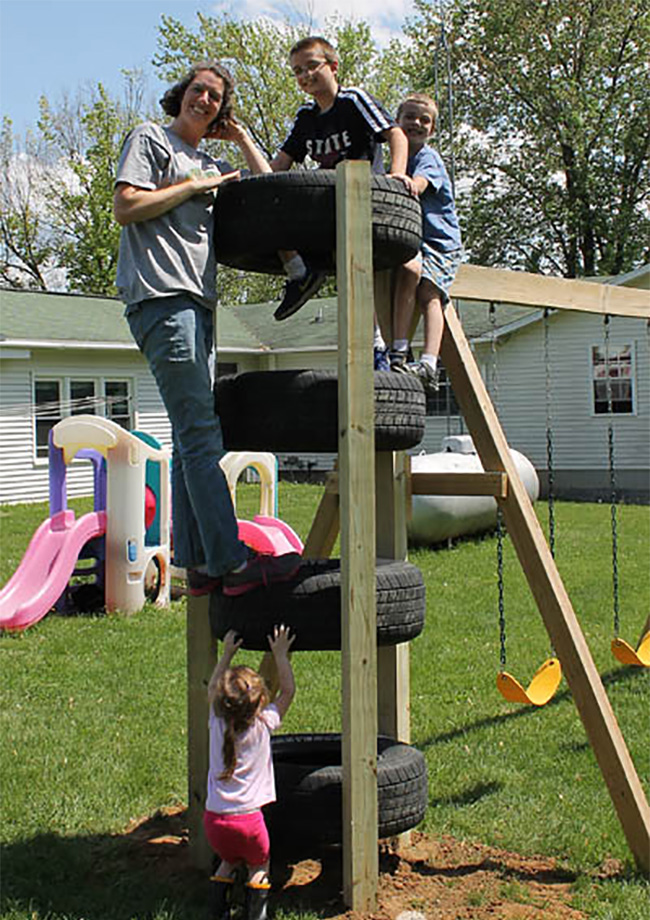What’s the best material to build children’s playgrounds from? The short answer is…it depends. It depends on what you can find locally, the prices of local materials, environmental factors (Is there flooding in your area? Termites? Strong wind?), and above all on the advice from local builders. The best materials for a playground in your community should be determined by what can be easily sourced, built, and maintained locally, which will enable your playground to be enjoyed for years to come.
Over the years, we’ve supported over 1,400 communities around the world to build playgrounds and many of them have utilized used tires as their primary building material. While tires may not work in every context, they are commonly used on playgrounds around the world because of their versatility. In this article, we’ll be exploring the benefits of building children’s playgrounds from used car tires as well as a few tips & tricks on tire playground building.
Let’s get started!
So why are used car tires a great material for building children’s playgrounds around the world?
1. Availability – Tires are found in nearly every community in the world. They’re easier to find in some places than others, but we’ve been hard pressed to find a location that isn’t able to scrounge up at least a couple dozen used tires. (And we’ve been to some really, really remote places.)
2. Easy to build with – Building with car tires doesn’t take any special skills. If you’ve got a few tires, an electric drill, a knife, a handful of bolts, and a shovel, there are a nearly unlimited number possibilities of designs you can build.
3. Safety – The majority of children’s playgrounds around the world are built from steel, which can pose safety hazards. In hot climates, steel elements in direct sunlight can get extremely hot and even burn children. Steel is also very hard and can hurt kids if they slip and fall or accidentally run in front of a kid swinging on a metal swing seat (a common problem.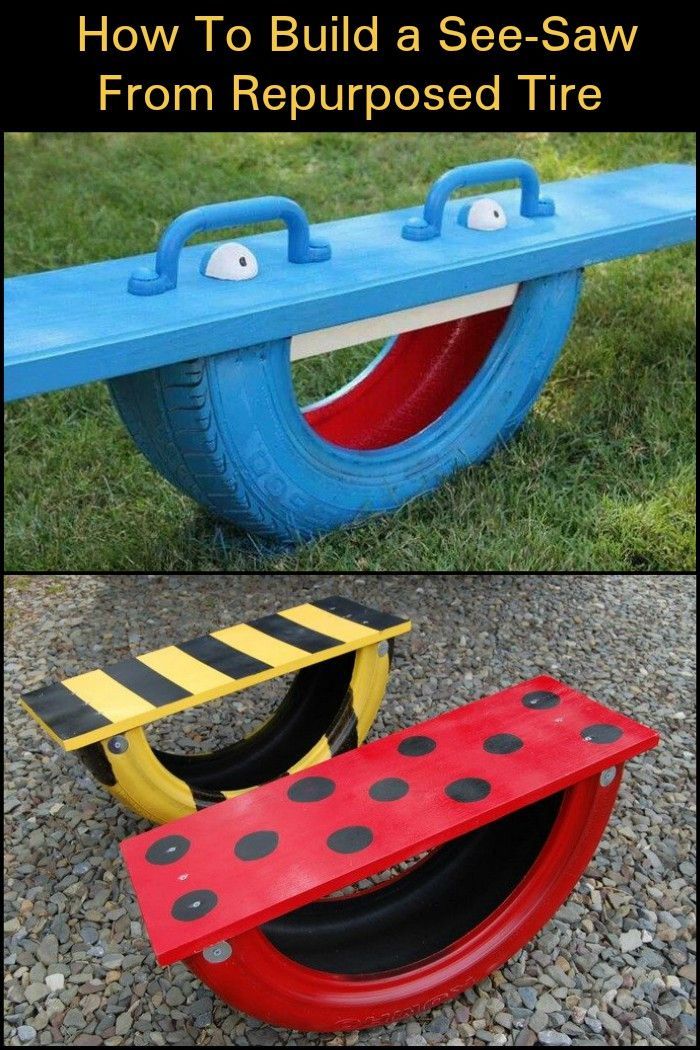 ) Tires, on the other hand, do not get nearly as hot in sunlight (especially when painted) and are forgiving if you fall down and bonk your head on them.
) Tires, on the other hand, do not get nearly as hot in sunlight (especially when painted) and are forgiving if you fall down and bonk your head on them.
5. Durability – Tires are made to hurl thousands of pounds of machinery down bumpy roads. They’re made to last. And they do. They’re also not susceptible to common environmental risks – like termites eating wood or weather rusting metal. Truck tires are especially durable and are preferable in many of our designs although then can be much heavier.
6. Affordability – Most communities can source tires for free or very cheap. We’ve built children’s playgrounds in some places where used tires are such a waste problem that they are often burned to dispose of them, releasing toxic fumes. In these areas, people are happy for you to take their used tires off their hands! In other areas of the world, old tires are used to make sandals, or other products, so they have a “value” in the local economy. In areas like this, we’ve sometimes had to pay a small price for tires and have factored this into the budget.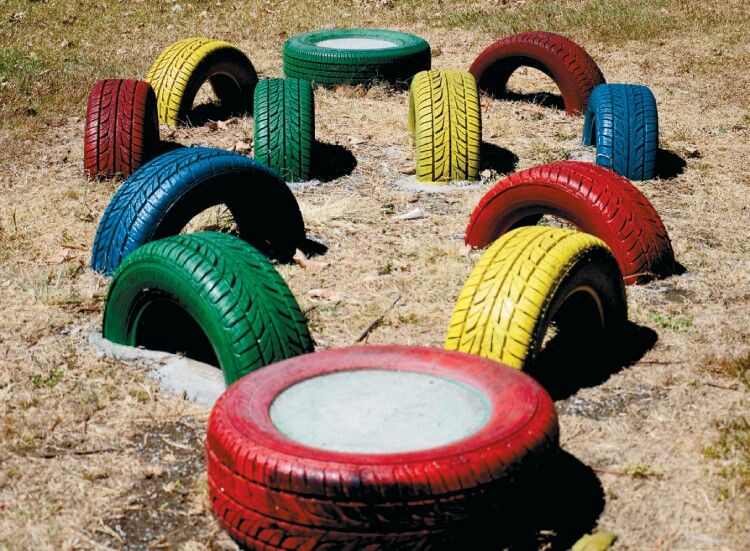
Designs
Playground Ideas has over a hundred children’s playground equipment designs that can be built from used car tires. Each design comes with free step-by-step DIY instructions and most require nothing more than a few bolts and an electric drill. Access all our used car tire designs in our Design Library.
Tire quality
Prior to using any tires, carefully examine the entire surface of the tire to ensure there are no steel wires sticking out. If there is a small patch of exposed wires, you can still use this tire if it is half buried in the ground with the exposed section in the ground. However, if the rubber has worn thin and there are exposed wires on half or more of the tire you cannot use it. Do not try to clip down or grind down these exposed wires – it just won’t work and can pose a serious hazard to children.
Drainage
One of the potential safety hazards in building tire playground is that if you do not take precautions, tires can collect water which can be a breeding ground for mosquitos. In areas of malaria prevalence, this can be a be a dangerous problem.
In areas of malaria prevalence, this can be a be a dangerous problem.
Luckily, it’s also an easy problem to avoid! Here’s how: on each element, cut or drill a hole at the lowest point of each tire. This will allow any rainwater to freely drain. After you complete the playground, double check each element to ensure that there is a drainage hole for every tire that could collect water.
Painting
To ensure that paint sticks to tires well, use high quality oil based paint. Used tires generally have a lot of oil and dirt on them which can prevent paint from sticking. You also don’t want kids getting leftover motor oil on their hands, so scrub down any tires you’ll use on the playground with soap and water and allow them to dry before painting and before children play on them. Generally it is easiest to do this all at once at the beginning of the build instead of trying to wash elements that have already been built. Prior to painting, you may need to do another quick wipe down to remove any dirt from constructed elements.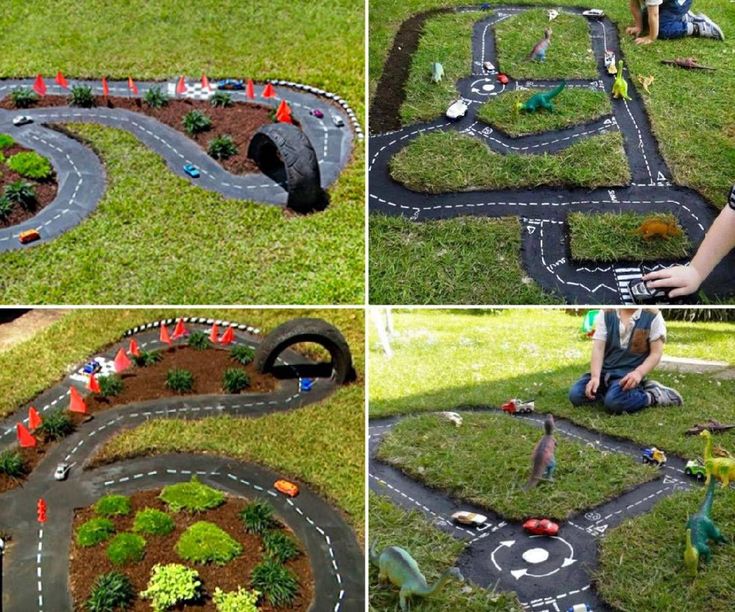
Further resources
For more info on building children’s playgrounds from used tires, be sure to check out our Playground Builder’s Handbook. It’s packed with more details and advice on building with tires, including ideas for sourcing tires, how to read sidewall numbers to differentiate different sizes of tires, and tips on how to easily and efficiently cut a tire. In addition, you’ll find guidance on planning, designing, building, and maintaining locally built playgrounds, regardless of what materials you choose to build from.
You don’t have to spend hundreds of dollars on sterile, mass-produced recreational equipment. Take Paul Hogan’s advice instead
You could hardly do the tykes and teens in your community a better service than to provide them with a joyful place to sport and cavort. A playground needn’t require scads of expensive prefabricated equipment, either, because you can build a better recreation set than commercial manufacturers offer .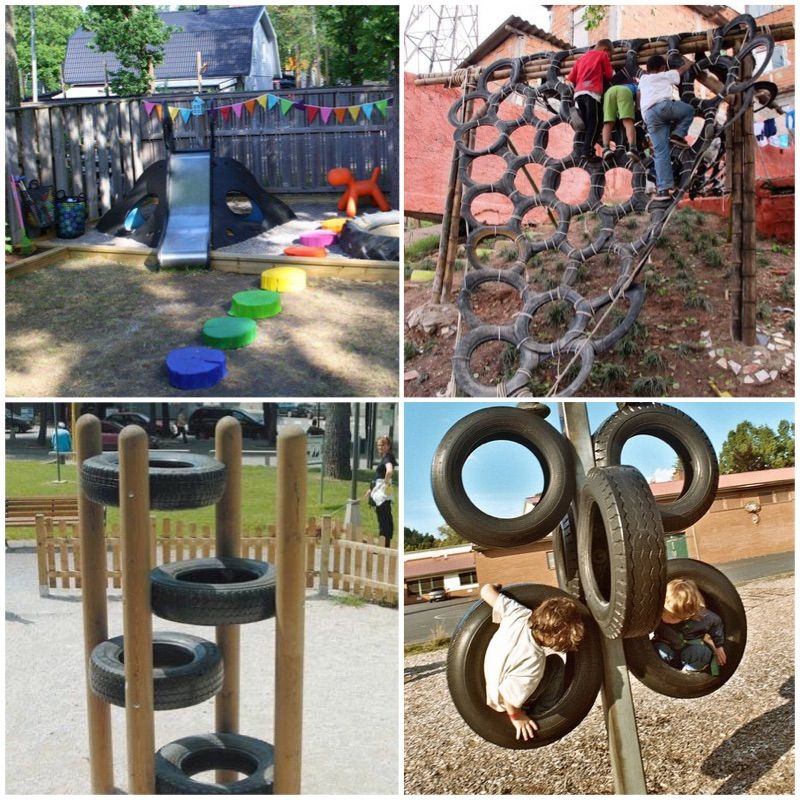 . . using discarded auto and truck tires! Millions of the worn-out “road riders” become junked giveaways every year . . . so why not work with your fun-loving youngsters (and recycle a bit of America’s trash in the bargain) to construct your own super-fantastic, whale-of-a-time, free playground?
. . using discarded auto and truck tires! Millions of the worn-out “road riders” become junked giveaways every year . . . so why not work with your fun-loving youngsters (and recycle a bit of America’s trash in the bargain) to construct your own super-fantastic, whale-of-a-time, free playground?
Please note that I just said you should work WITH the children. I started designing “outdoor rumpus rooms” years ago, and have since helped over 250 communities — from Ottawa to Tennessee — create their own playgrounds. The successes and failures I’ve experienced in these projects have taught me one vitally important lesson: Never build playgrounds without the total involvement of the children who will be using them!
There are several good reasons for “employing” youthful design and construction crews. For one thing, young people should be allowed to help develop their own play space. After all, most adults enjoy laying out a vegetable patch or redesigning their own homes . . . and young folks can have a lot of fun helping to shape their own “environments”, as well.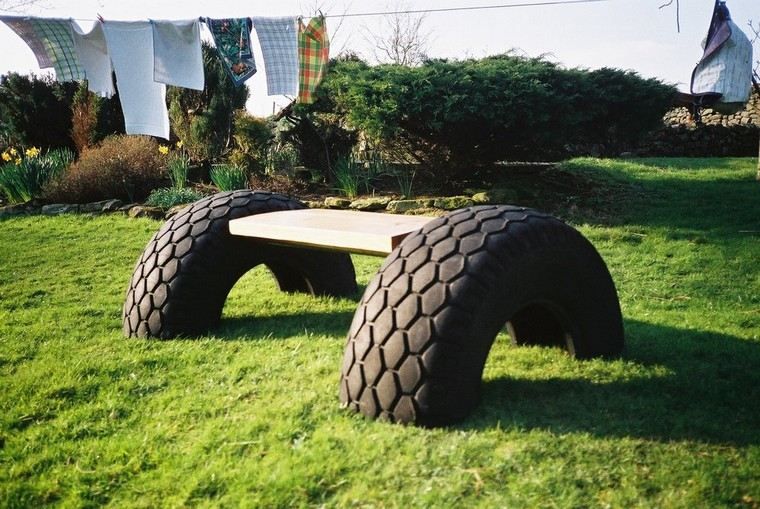 (Remember, too, that one meaning of the word recreation is “the act of building anew”.)
(Remember, too, that one meaning of the word recreation is “the act of building anew”.)
In addition, your pre- and post-pubescent planners will make sure the finished structure is built to “scale”, and that it includes playthings the children themselves will want to use. All too many professionally designed playgrounds go un-enjoyed because they simply don’t appeal to young’uns!
More important, though . . . “offspring architects” may be necessary for a playground’s survival. When outdoor fun sites are designed and put up by adults, children will often “re-create” the parks in the only way they can . . . by destroying them! If these same individuals have their hands in the planning and development of the game ground, however, the juveniles will want to maintain — maybe improve — their structures . . . rather than damage them.
Once you corral some “constructive” youngsters (this should be an easy task, as most children will be eager to help!), all you’ll lack is your raw material: tires.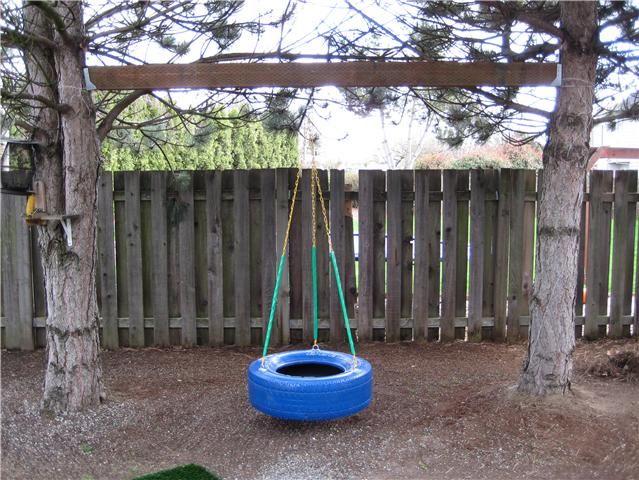 Fortunately, an almost infinite number of old highway handlers can be had just for the scrounging.
Fortunately, an almost infinite number of old highway handlers can be had just for the scrounging.
What’s more, big truck or tractor castoffs are just as easy to secure — and “just as free”as are the smaller automobile wheel coverings. In fact, you can even get huge pneumatics (tires that often cost over $10,000 new) delivered to your playground! Simply phone your local quarry, road builder, or state highway department and convince the folks at these business offices to donate their casings to a worthy cause . . . the area’s children.
Remind the firms’ owners that they can take a tax write-off by giving their play objects to your community association or school . . . and probably save a dumping fee, besides. Chances are such business people will like your idea so much they’ll thank you for asking! Then — if you pick a spot or dig a hole for each tire before the big delivery — the donors will likely unload the rejected rubber giants right where you want ’em!
After you’ve garnered a collection of large and small tires, you’re ready to let your — and the youngsters’ — imagination run loose. To get you started, I’ll describe for you some structures I’ve built with other playground people. Perhaps our ideas will motivate the “think tanks” in your group . . . then you can invent some really zany recreation ideas and pass them on to me!
To get you started, I’ll describe for you some structures I’ve built with other playground people. Perhaps our ideas will motivate the “think tanks” in your group . . . then you can invent some really zany recreation ideas and pass them on to me!
Canadian Log Roller. These rubber balance “logs” are child’s play . . . to make and to use! Just drill three equidistant holes through the sides of a bunch of “matching” tires (we’ve strung together as many as 10 of ’em!), and connect the casings with nuts and bolts. Be sure, though, to add extra wide washers on both sides of your hookups to keep the tires from tearing and separating. (In fact, install large washers whenever you bolt “wheel bracelets” together, and always cut drain holes in the lower portions of your casings to allow rainwater to run out.)
Many small fry play with the log by having one person ride inside while two or more children try to roll — and stay on top of — the rubber cylinder. This enjoyable game has only one official rule: When the tot inside hollers “stop”, the others must pause to let the well-spun youngster out.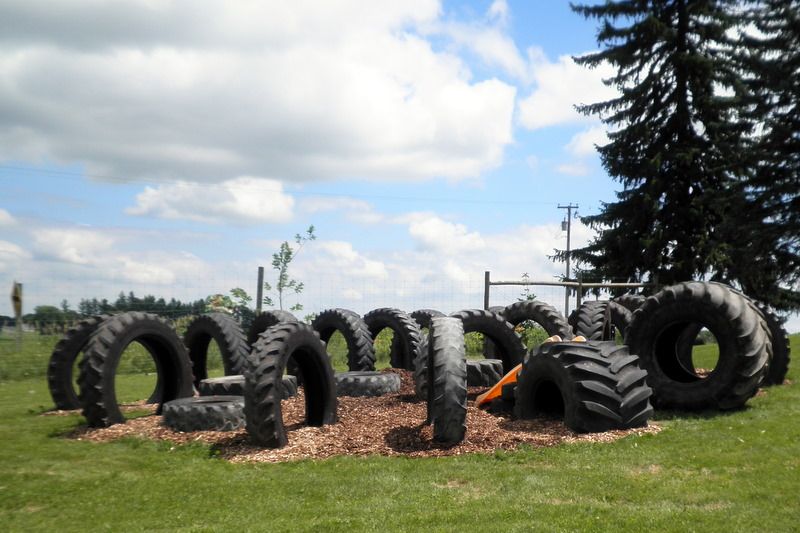
Tire Tunnels. Just about every child loves to crawl through tunnels, so most playground builders plop a few concrete culverts somewhere on the lot. The huge pipe just doesn’t make as good a tunnel as does a set of large-hole farm tractor tires, though: Precast culverts are a lot of trouble to move into place, and more important — are much less safe than are their softer counterparts. (Which would you rather bump your head against . . . concrete or rubber?)
To make a tire tunnel, dig a big trench and line the ditch with some drainage material (such as gravel or sand). Roll your big rounds in place (drain holes down) and bolt the tires together, using two-inch-diameter (or larger) washers. Then backfill and tamp some dirt in the bottom of your passage to provide a level “floor” and to keep the structure from rolling.
When I help folks build tire tunnels, we’re always careful to pave the inside of the tube with used conveyor belting that we obtain for free from manufacturing companies.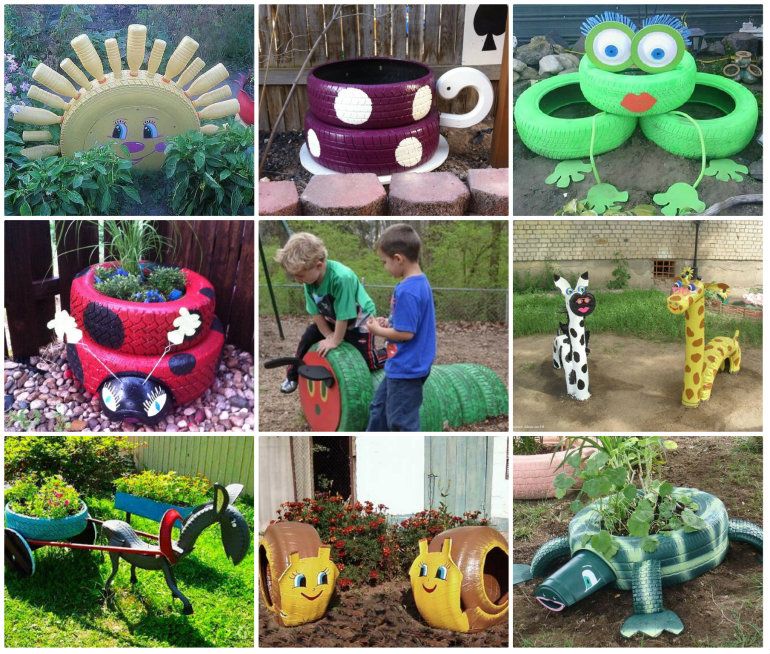 We anchor this knee protecting material just outside the tunnel’s ends by nailing it to buried wooden railroad ties or “sunken” pieces of utility pole. Rubber belting also makes a good safety surface for many other playground spots. You can lay it under swings and climbers, or any place where the children might hit a hard surface or perhaps wear the ground away.
We anchor this knee protecting material just outside the tunnel’s ends by nailing it to buried wooden railroad ties or “sunken” pieces of utility pole. Rubber belting also makes a good safety surface for many other playground spots. You can lay it under swings and climbers, or any place where the children might hit a hard surface or perhaps wear the ground away.
Tire Caves. You can also partially bury tires to set up a series of hoop caves. The circular grottoes will give off eerie echoes when a child talks or hollers inside . . . and make some “hilly” climbing for those who’ll want to clamber along the top. The youngsters at the school where these caves are located were responsible for the dens’ fancy paint jobs. Furthermore, the artistic “little folk” don’t just rest on their rubber laurels . . . they redecorate the caverns every year! (By the way, it’s best to use water-based paint on tires. For some reason, oil-based coats have trouble drying!)
Tire Tipi.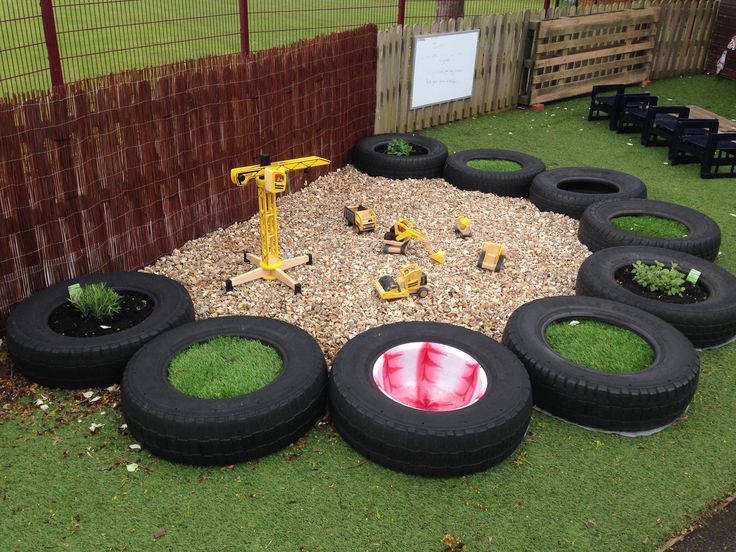 This casing “conestead” is a lot of fun to build and play on. We make our tipis three or four rounds tall for little tykes, and as big as possible for the “older” people. You can construct spaces between the tire layers by setting metal sleeves and washers on 6- to 12 inch galvanized fastening bolts. The gaps will make the tipi taller, easier to climb. . . and “springier” as well.
This casing “conestead” is a lot of fun to build and play on. We make our tipis three or four rounds tall for little tykes, and as big as possible for the “older” people. You can construct spaces between the tire layers by setting metal sleeves and washers on 6- to 12 inch galvanized fastening bolts. The gaps will make the tipi taller, easier to climb. . . and “springier” as well.
A tire tipi can be built by a crew of three people in a few hours. Once the structure is finished . . . each round plays the part of a coil on a giant spring, so the whole apparatus can rock excitingly to and fro like a sailboat in a heavy sea. (And don’t worry about the cone tipping over. I once challenged 10 teenagers to upset a tire tipi, and those strapping adolescents couldn’t do it. Well . . . at least not until they “cheated” by lassoing the top with a long rope and tugging on it for all they were worth!)
TireSandbox. The tractor-tire sandbox is an old idea, but we’ve updated the concept some by cutting off one side of the casing to give the play circle more open space.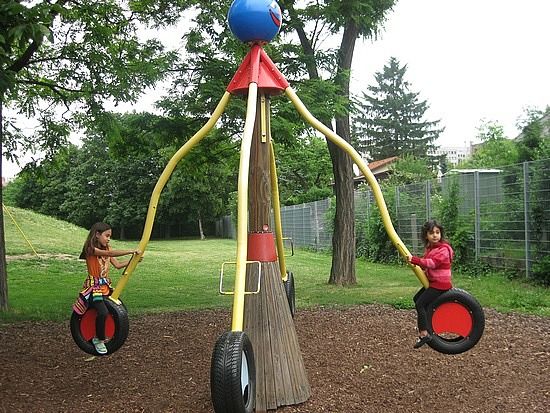 (A dry-wall cutter — or any sharp razor-type knife — makes a fine tire-trimming tool.) And don’t forget to drill drain holes in the “pneumatic’s” lower side . . . or your sandbox may turn into a quicksand box.
(A dry-wall cutter — or any sharp razor-type knife — makes a fine tire-trimming tool.) And don’t forget to drill drain holes in the “pneumatic’s” lower side . . . or your sandbox may turn into a quicksand box.
Rubber Alligators. If you’d like to give your playground a touch that every young Tarzan will love, just make a “threadbare” alligator out of an old tractor tire . . . and nail the rubber hide to a low log bench. Young folks can then pull Ally’s tail all day . . . “without getting eaten once”. We used a chain saw to cut out the reptile’s jaws, but that tricky task should only be attempted by someone who’s an expert at handling the dangerous tool.
Tire Climber. It’s easy to build an obstacle-course climber. . . if you erect it one row at a time (nobody could lift the whole thing!). Just remember the old tire rules: Use large washers to keep the rubber from tearing, and always drill drain holes. The children who worked on this climber wanted to “salute America”.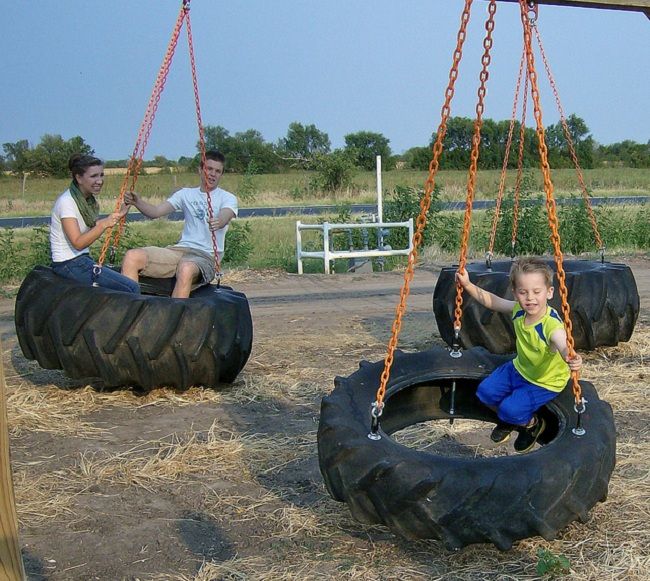 . . so they turned their “rubber curtain” into a tire flag!
. . so they turned their “rubber curtain” into a tire flag!
Miscellaneous Tiretry . The use of tires is limited only by the number available.
I’m not kidding, either! Tires can be stacked into mountains (or hide-and-go-seek mazes) … built into dome-shaped jungle gyms . . . fastened along the sides of posts to make “trees” . . . suspended as bridges . . . “sculpted” into play cars or boats … made into hammocks … laid out as roly-poly walkways . . . and more, more, more! And — as you may have noticed — I haven’t even mentioned tire swings! It would take another whole article to describe the many great designs for rim-riding “swaythings”.
So please, don’t let a lack of funds stop you from helping your youngsters have a great place to play. (And don’t let a surplus of moneys lure you into buying outdoor equipment, either.) Because with a little bit of scrounging — and a lot of inventive young volunteers — you can put together a playground children will never get “tired” of!
Whenever you and your
troops head out on a used tire “scavenger hunt”, be sure to snatch up all
the used inner tubes you find along the way.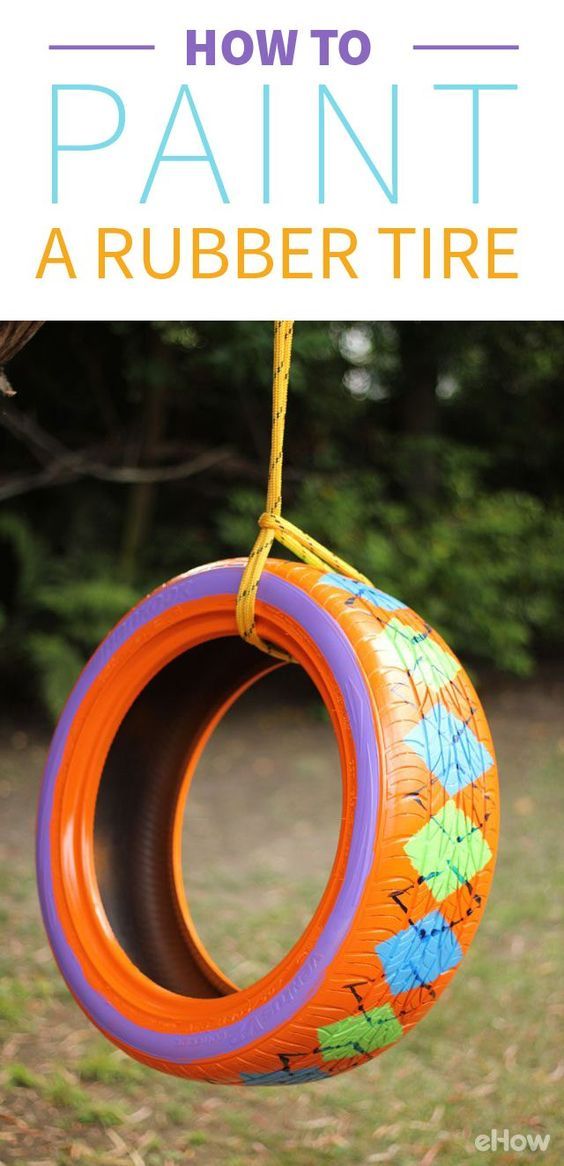 Many of the deflated
Many of the deflated
“doughnuts” you discover probably won’t hold air. . . but don’t fret:
Simply select tubes with leaks that can be repaired. Once you fix and inflate
those punctured “air holders”, they’ll provide your young’uns with
hundreds of ways to have fun . . . just as tires do!
Bigger children can, for instance, let off a little
steam — harmlessly — by having inner tube “pillow fights”.. . or by
climbing into truck tubes and trying to roll down a hill. For your younger
charges, just set a “net” of the easily stored inflatables on the
ground. The little tykes will jump at — and all over — this chance to practice
their “trampolining” The tots can also take their storytime rests in
the airy cushions.
Inner tubes are even good for winter games. In
fact, the pneumatic doughnuts make especially great sleds because nobody gets
hurt in a collision!
So haul a passel of “tubes” out to a
playground, then let the youngsters have at ’em! The former tire fillers will
suddenly become bumpers, back stops, safety nets, “giant ring
toss”hoops .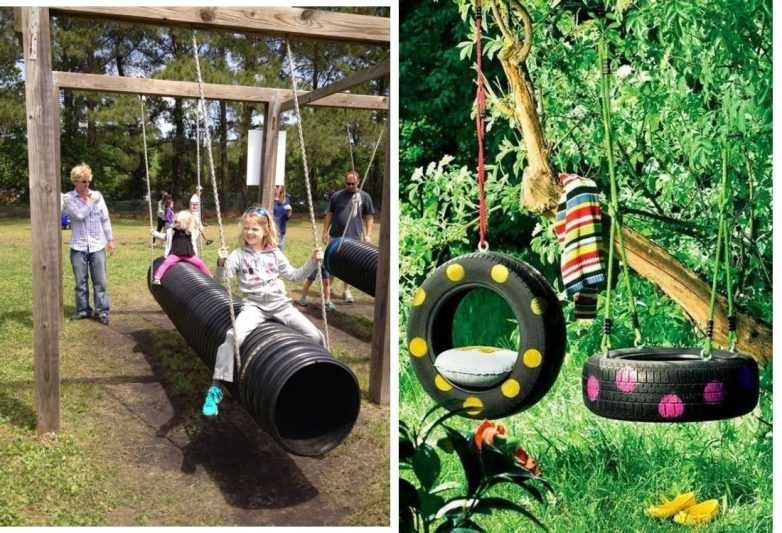 . . and more. You’ll be astounded by the clever uses children
. . and more. You’ll be astounded by the clever uses children
can create for these flexible “toys”. Why, one young fellow claimed
that he even played with an inner tube while he was swimming!
Of course, that idea did seem a bit far-fetched . .
. .
If you are a modern parent, then the safety of your child is very important to you. Surely, you do not want to let him go for a walk in various places that do not inspire confidence in you. And you don't have to. Indeed, today, from simple materials, you can equip a playground with your own hands, where every child will like to spend their free time and play various games there. In this publication, we decided to offer you the most interesting tire crafts for the playground. We hope you will be tempted to make one of these and set it up in your child's play area.
Tire swing.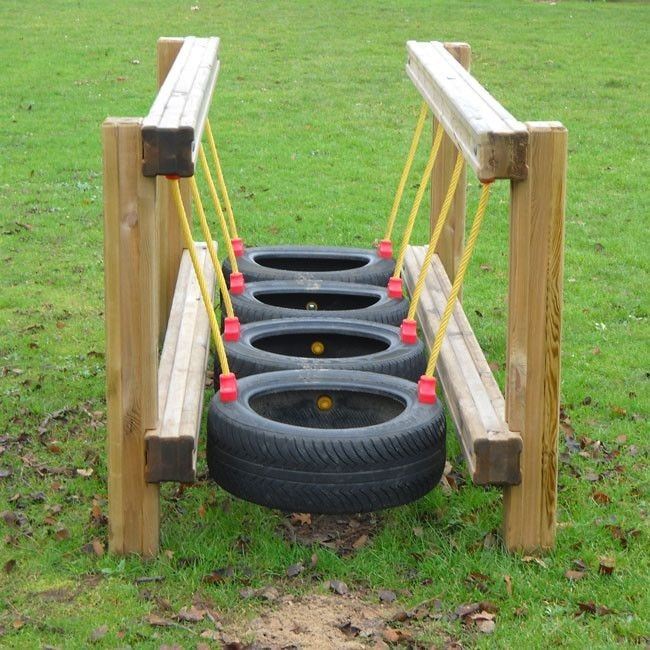
If you have old car tires at home, you should not throw them away. It turns out that you can make a large number of crafts from them that can take their rightful place on the playground. Crafts from tires to the playground can be very diverse. It is worth looking at only the photo and finding the best option for crafts.
The first and easiest craft is a tire swing. To make such a swing is worth a little work. First you must position the tire horizontally. In it you must make 3 or 4 holes. Metal hooks are inserted into these holes. You must fix them with nuts and washers. And in the loops of the hooks you must thread strong threads or chains.
That's all the DIY tire swing is ready for your playground. And to make the swing look pretty, you can decorate it in a bright color.
Tire chairs.
On the playground that you plan to equip with your own hands, it is worth installing comfortable chairs that you can place around the perimeter of the entire playground.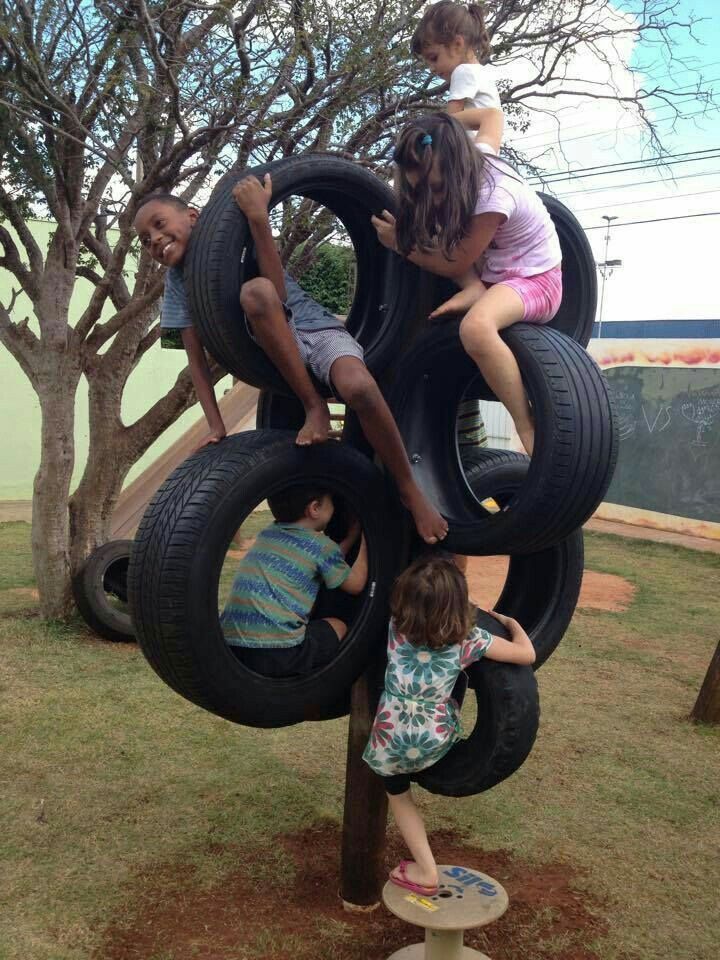 Making these chairs is very easy. And here you can get by with improvised tools. In addition, in this case, you will have to use paints in order to make the chairs beautiful.
Making these chairs is very easy. And here you can get by with improvised tools. In addition, in this case, you will have to use paints in order to make the chairs beautiful.
Tire frog.
All children like toys. And if your playground lacks some fairy tale, then you can furnish it with cute figurines. If you are a creative person, then you can create extraordinary beauty. We propose to make a beautiful frog, which, for sure, will attract the attention of many children.
Tire sandbox.
A child's favorite pastime is playing in the sand. And so on the playground you must have a sandbox. And it will be very easy to build. Look at several options, we hope that you will be able to find the perfect option that will also please your child.
Bike from old tires.
In this article, we list all car tire crafts for the playground. No playground can exist without a car.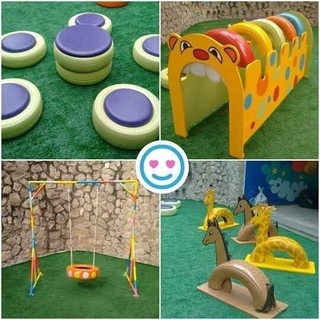 Therefore, we will talk about how to make a motorbike from unnecessary tires. It's worth the effort here. You should prepare:
Therefore, we will talk about how to make a motorbike from unnecessary tires. It's worth the effort here. You should prepare:
This craft is very easy to make. Examine the photo in order not to make mistakes.
Tire snail.
To create such a snail, you should take:
And if you work a little, then you can get a unique craft that will enchant you with its attractiveness.
In conclusion
Now you know what crafts you can make from old playground tires. We, in turn, do not advise you to throw away such products. And all because you can get real works of art, which in any case will not be left without attention.
Children's playground from tires, as well as a variety of other ideas from old tires, are taken from the Soviet Union.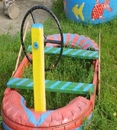 The first wet snows began to fall, and the temperature dropped below zero. It's time to change the tire from summer to winter. Now the question arises, where to put them if you don’t want to fill up the landfill with them? For example, let's use the idea, and we get a wonderful playground made of tires.
The first wet snows began to fall, and the temperature dropped below zero. It's time to change the tire from summer to winter. Now the question arises, where to put them if you don’t want to fill up the landfill with them? For example, let's use the idea, and we get a wonderful playground made of tires.
People with experience advise using foreign rubber for manufacturing, as it is more convenient to work with them, and Russian-made rubber is very hard, it will be difficult to work with it.
Winter tires are also good as a basis for the product - they are easier to turn out and bend. To make this craft you will need:
Do-it-yourself children's playground, made using tires, is quite common. This type of material is very versatile for making a platform with your own hands, you can find extraordinary masterpieces, what is the most interesting thing for children? For starters, these are budget sandboxes to create a nice place to play from a couple of tires.
This type of material is very versatile for making a platform with your own hands, you can find extraordinary masterpieces, what is the most interesting thing for children? For starters, these are budget sandboxes to create a nice place to play from a couple of tires.
It will take a little more time to make a sandbox in the form of a flower, as a result it will turn out larger, several children will fit in it at once.
To create a craft you will need:
The tire is cut lengthwise into two parts and the edges are trimmed with a hose. Tires are placed in the shape of a flower in a previously prepared small hole in the shape of a flower. For convenience, you can put a stump or a round seat in one of the petals, you get a comfortable table or chair for adults. At the junction of the tires, they are connected to each other using a stapler. We color the resulting flower and add sand.
We color the resulting flower and add sand.
And when the children grow up, you can replace the sand with earth and create a beautiful flower bed, in which case you can put another tire in the center.
A playground for children cannot do without swings, they can also be placed in the garden. Our site, created with various tire products, is no exception, as there are many examples.
The most important aspect in making a swing is a good fastener. Hanging points and rope must be very strong. The choice of swing type is yours.
Light swing made of tires for adults and children: the tire is fixed on a rope vertically or on 2 ropes horizontally. This will add attractiveness if you cut out various shapes and designs from the tire. The most important thing at this stage is to make the tire support points very secure.
Baby swing as pictured above. Detailed creation tutorial:
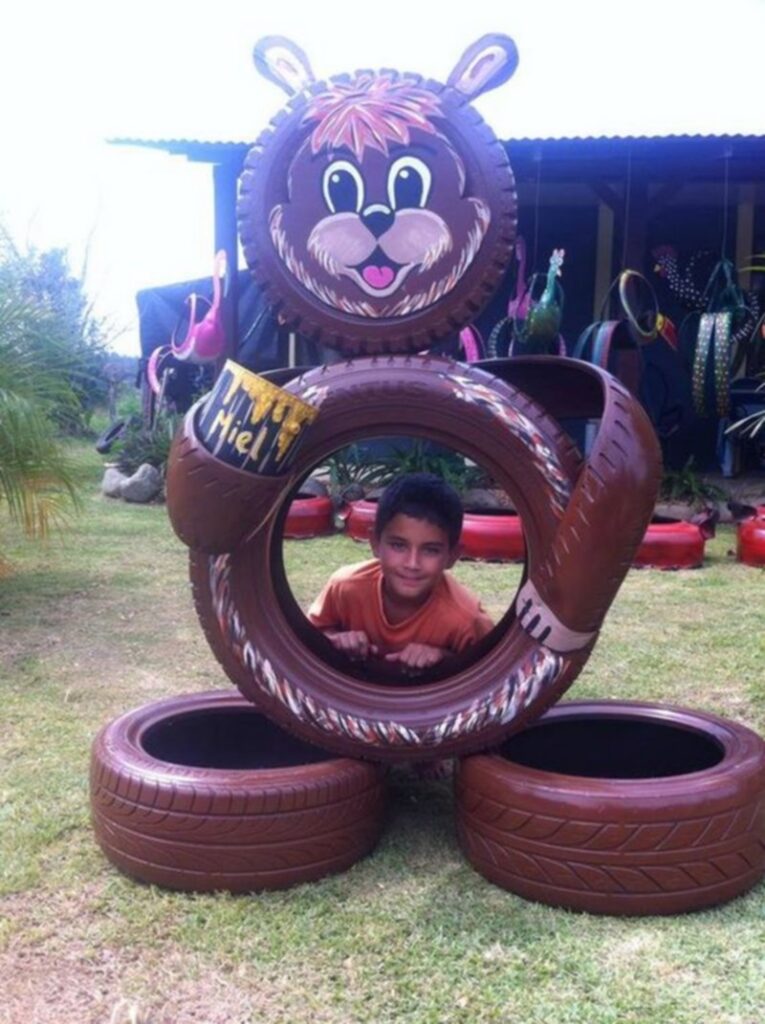
Wonderful swing for tiny children is finished.
Rocking chairs are easy to make with your own hands and are very interesting for children. You will need the following: a tire, a plank, or another object that is suitable as pens.
Making such an interesting and at the same time simple item is easy. We need the following items:
Using a hacksaw and cutter, cut the tire into two pieces. To half of the tire with the help of fastening material, we fix the plank along the cut lines. Then it remains only to paint the swing and decorate with decorative elements.
At the playground, children cannot sit still, and sometimes swings and sandboxes are not enough, they always want to climb and jump somewhere. For such energetic children, various simulators and slides will be an excellent method for playing.
For such energetic children, various simulators and slides will be an excellent method for playing.
Tires are great to make as they will satisfy kids and also rubber products are quite safe. Often installed on site:
Tire walkers buried one by one in one lane. Such products will immediately serve as a fence that separates the playground from other areas.
The next type of simulators will be obtained if the tires are arranged horizontally in series, with a distance of half a meter between them.
In an area where there is a lot of space and no boundaries, a good choice for children would be a simulator in the form of flat tires, a large number of tires will be required, at least ten.
Gorka. A great tire attraction that you can create yourself and there are many options:
